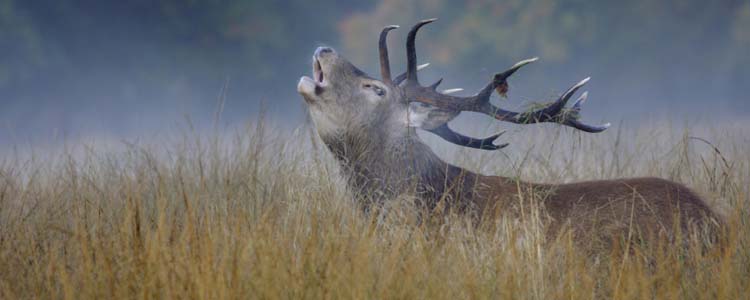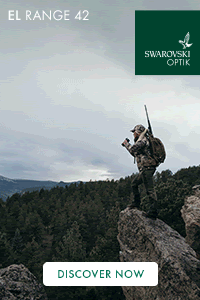Jonty Drew gives us his first impressions of the Hikmicro FQ50L Falcon 2.0.

The first time I took the Hikmicro Falcon 2.0 into the field, I didn’t quite know what to expect. It was a cold, misty January morning, one of those days where the world feels soft and half-asleep, and you half-wonder if anything will stir at all. As I crept along the edge of a patchy woodland, the Falcon slung loosely over my shoulder, it struck me how much a successful deer stalking outing often relies not just on skill, but on having the right bit of kit to make the difference.
Lifting the Falcon to my eye for the first proper scan revealed a group of roe deer, utterly invisible just moments earlier, appearing as bright, clear shapes about 300 yards out, perfectly distinct against the cooling landscape. It was effortless. Instantly, I felt that slight swell of quiet confidence that comes when you know you’re one step ahead.
As the light began to build, the Falcon didn’t falter. In the half-light, where colour drains from the world and outlines blur, it remained precise and vivid. To the right of me, a lone roe doe stepped cautiously through the woods, her movements clear and defined against the warming earth. Switching between “White Hot”, “Black Hot” and the various other settings, depending on the background, made it easy to pick her out from the muddle of the undergrowth. Even the flick of an ear, the shift of weight between legs, small things that you might normally miss, stood out in sharp relief.
It quickly became clear that the real strength of the Falcon lies in the detail it captures. This isn't one of those thermals where you’re guessing if the blob is a fox, badger or muntjac. You can easily make out the species and species characteristics with this unit and at sensible ranges for stalking, it takes a lot of the uncertainty out of things.
In terms of range, the Falcon has more than enough. It’s rated out to well over a kilometre, but realistically in the lowland woods and field margins where most of us do our stalking, you're dealing with a few hundred metres at most. It’s reassuring to know, though, that even a cautious fox slipping the far edge of a field won't escape your notice. The image stayed sharp and smooth even with quick scanning – no lag or fuzzy patches, just crisp, real-time movement.

Battery life was another pleasant surprise. On a full charge, it comfortably handled a full morning’s outing with scanning here and there. I never felt I had to ration its use or worry that it might die just as the action started. Knowing you can carry a spare battery easily, and swap it in seconds, removes any real worry about getting caught short. That said, the battery latch mechanism is a bit fussy – not difficult, but it does have a definite click if you aren’t careful. In a high-stakes moment next to a skittish animal, that’s something you’d need to manage quietly. Likewise, the lens cap flips up on a firm snap – fine when you’re pottering about, but it demands a gentle hand if you're stalking close.
What’s clear is that the Falcon has been built with stalkers in mind. The body feels solid but not heavy, the buttons fall naturally under the fingers, and it’s intuitive enough that within minutes you aren’t thinking about how to use it anymore – you’re simply using it. Focus adjustment is smooth, easy to tweak as you move from near to far, and the eyepiece gives a sharp, comfortable view that doesn’t strain the eye. Even the standby mode, which lets you kill the display instantly and revive it just as quickly, speaks to a device designed by people who actually spend time in the field.
If there’s a minor gripe beyond the small bits of noise from the latch and cap, it would be the digital zoom. While it's there and useful to a point, push it much beyond 2× or 4× and the image starts to pixelate. But realistically, in proper stalking distances, that’s a very minor concern – you’ll rarely need to zoom far when you can simply move closer, and the image at base magnification is excellent.
All in all, the Hikmicro Falcon 2.0 feels like a genuine step forward for thermal monoculars at this level. It’s not a gimmick; it’s a practical, trustworthy companion that quietly makes stalking more effective and sometimes more enjoyable. There’s a slight learning curve, of course – learning to open things silently, to scan smartly, to trust your eye not just to spot but to interpret what you see. But those are good habits in any case.

It’s not a cheap bit of kit at around £2600, and it won't make a stalker out of you if you haven't got the basics. But if you already know your way around a wood, if you value those small edges that turn sightings into opportunities, then the Falcon 2.0 is an investment you won’t regret. In short, it's a piece of equipment that earns its place in your pocket – and more importantly, earns your trust when the first movement of the morning finally emerges from the mist.
If you're interested in leaning more about Night Shooting Technology you can Enrol on the LANTRA Night Shooting Course via the Shooting & Hunting Academy here: Night Shooting Course
If you’d like to start deer stalking but don’t know where to get started then visit the Shooting & Hunting Academy where you can find the Proficient Deer Stalking Certificate Level 1 PDS1, it’s the perfect place to get started. Proficient Deer Stalking Course - PDS1



















